![]()
The Governor's budget assumes that the U.S. and California economies will slow significantly in 1999 relative to their recent performances, before
rebounding slightly in 2000. As shown in Figure�6, real GDP is projected to increase 1.9�percent in 1999, or slightly more than one-half the rate of 1998.
In California, wage and salary employment is projected to increase 2.1�percent this year and 2.4�percent in 2000, compared to 3.2�percent in 1998, while
personal income growth is projected to increase by 5.1�percent and 5.5�percent during 1999 and 2000, respectively, compared to 6.3�percent in 1998.
Key factors cited for the expected national slowdown include more-moderate gains in consumer spending and business investment, along with continued
weakness in the international sector. California's economy is expected to slow in line with the nation's, reflecting the continued effects of Asia's problems
on the state's high-tech sector. The budget assumes that state employment and income growth will continue to exceed the nation's in both 1998 and 1999,
due to continued growth in California's building sectors.
| Figure 6 | |||
| Summary of Budget's Economic Outlook | |||
| 1998 | Projected | ||
| 1999 | 2000 | ||
| United States Forecast | |||
| Percent change in: | |||
| Real GDP | 3.6% | 1.9% | 2.2% |
| Pretax corporate profits | -3.1 | -5.2 | 0.5 |
| Unemployment rate (%) | 4.5 | 4.8 | 5.1 |
| Federal funds interest rate (%) | 5.4 | 4.6 | 4.3 |
| California Forecast | |||
| Percent change in: | |||
| Personal income | 6.3% | 5.1% | 5.5% |
| Wage and salary jobs | 3.2 | 2.1 | 2.4 |
| Taxable sales | 5.6 | 5.4 | 5.4 |
| Consumer Price Index | 1.9 | 2.4 | 3.0 |
| Unemployment rate (%) | 5.8 | 5.8 | 5.8 |
| New housing permits (000) | 126 | 152 | 166 |
While the budget forecast is consistent with other economic forecasts made last fall, strong year-end economic data, coupled with the rebound in the stock market, has prompted many forecasters to significantly raise their projections for 1999. As one example, Standard & Poor's DRI, which is among the largest of the national economic consulting firms, raised its forecast of real GDP growth from 1.9�percent as of November to 2.7�percent as of January. While this renewed optimism could be undercut by further negative developments abroad or by a sustained drop in the U.S. stock market, it is nevertheless the case that the administration's forecast for both the nation and California is currently on the conservative side of the "economic consensus" of projections.
Reflecting recent positive developments, the LAO's revised economic forecast calls for higher rates of growth in the U.S. and California economy than does the budget forecast. Our national and state projections are summarized in Figure�7.
| Figure 7 | ||||
| Summary of LAO's Economic Outlook | ||||
| 1998 | Forecast | |||
| 1999 | 2000 | 2001 | ||
| United States Forecast | ||||
| Percent change in: | ||||
| Real GDP | 3.8% | 2.6% | 2.1% | 2.0% |
| Personal income | 5.0 | 4.6 | 4.4 | 4.3 |
| Wage and salary jobs | 2.5 | 1.7 | 1.6 | 1.4 |
| Consumer Price Index | 1.6 | 2.2 | 2.4 | 2.5 |
| Unemployment rate (%) | 4.5 | 4.5 | 4.6 | 4.9 |
| Housing Starts (000) | 1,614 | 1,585 | 1,500 | 1,480 |
| California Forecast | ||||
| Percent change in: | ||||
| Personal income | 6.4% | 5.4% | 5.6% | 5.4% |
| Wage and salary jobs | 3.2 | 2.4 | 2.6 | 2.4 |
| Taxable sales | 5.8 | 5.5 | 5.4 | 5.2 |
| Consumer Price Index | 2.0 | 2.4 | 2.7 | 2.9 |
| Unemployment rate (%) | 5.9 | 5.8 | 5.5 | 5.6 |
| New housing permits (000) | 125 | 144 | 172 | 175 |
We assume that real GDP will slow from 3.8�percent last year to 2.6�percent in the current year, and then taper a bit more to 2.1�percent in 2000. Our projections assume that Asia's problems will continue to have a negative effect on net exports through most of 1999, and that both consumer and business spending will slow some in 1999 relative to their above-average rates in 1998. Even with these slowdowns, however, we expect that the pace of economic expansion will remain moderate. Positive near-term factors include: high levels of consumer wealth, confidence, and real incomes; continued low interest rates; and continued strong business fixed investment, driven by businesses' need to modernize and increase output per worker in a tight labor environment.
Our forecast assumes that inflation will increase modestly over the next two years, with growth in the CPI rising from 1.6�percent last year, to 2.2�percent this year, and to 2.4�percent in 2000.
We forecast that economic growth in California will subside this year, yet continue to expand at a moderate pace. We forecast that personal income will increase by 5.4�percent in 1999 and 5.6�percent in 2000, compared to 6.4�percent in the prior year. Our projections assume that California employment and personal income will grow faster than for the nation as a whole throughout the forecast period (see Figure�8), reflecting the relatively positive outlook for the state's construction, finance, and services industries.
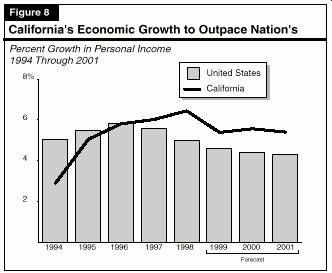
The past year marked a change in the forces behind, and characteristics of, California's economic expansion. The key elements of this change (depicted in Figure�9) include shifts in leading industries and regional growth patterns within California.
| Figure 9 | ||
| Contrasts in California's Economic Expansion | ||
| 1995 Through 1997 Versus 1998 Through 2000 | ||
| 1995 Through 1997 | 1998 Through 2000 | |
| General Features | High technology and export-driven gains in computer hardware and software industries. | More diffuse and internally driven growth, related to population, income, and wealth. |
| Leading Industries | High-tech manufacturing and services. | Construction finance, retail trade, and varied services and manufacturing activities. |
| Regional Aspects | Focused in north. | Focused in south. |
Leading Industries. The earlier stage of this expansion was led by booming growth in the high-tech and international trade-related industries, while the current phase is being led by internally-driven factors, such as rising population, wealth, and income within the state. These have caused a shift in the nature of the job growth that is occurring. Namely, the earlier expansion in high technology-related employment is being replaced, in part, by increases in construction, finance, services, and a variety of manufacturing industries outside of the high-tech categories.
Regional Patterns. With these industry changes has come a shift in employment growth patterns between the major geographic economic regions of the state. Year-over-year growth in jobs has subsided in the San Francisco Bay Area, due largely to an abrupt slowdown in employment in Silicon Valley. Offsetting this slowdown, however, has been a pickup in job growth in Southern California. We expect these trends to remain in effect through the forecast period.
Reflecting these changes, we expect that the fastest growing job sectors in 1999 will continue to be those most directly related to growth in population, income, and wealth--namely, construction, services, finance, and various manufacturing industries outside of the high technology sector.
We believe that the industry growth patterns evident in 1998 (shown earlier in Figure 2) will remain in place through the forecast period. In particular, we expect that healthy gains will be experienced in construction, services, and finance industries, with more-moderate gains in retail trade, utilities and transportation, manufacturing, and government. Within the state's large services industry, we expect continued strength in business services--partly related to growth in software design--as well as in the areas of health care, engineering, architectural design, engineering, and management.
Subsectors within the manufacturing sector will continue to experience divergent performances. As indicated earlier, we expect that the state's computer and electronics industries will continue to experience job losses through most of 1999 before recovering in 2000. In addition, we expect that employment in the aerospace industry will fall over the next two years, reflecting announced job reductions by Boeing, Northrop-Grumman, Raytheon, and other aerospace companies. Employment in manufacturing industries outside these high-tech areas should experience moderate gains over the next two years.
A key to California's economic outlook is the continued growth in the real estate sectors. These sectors were very strong in 1998, characterized by record-high home sales, rising home prices, and substantial increases in both residential and nonresidential construction activity. Sales of single-family detached homes increased 13�percent to over 650,000 units (annual rate) in the third quarter of 1998, the highest quarter on record. The median price of homes sold reached $206,000 during the same period, up 9�percent from the prior year.
The increase in housing activity has translated into higher building rates. Permits for new construction climbed to over 130,000 in the second half of 1998, the highest level since 1990. Nonresidential construction activity also was up sharply in 1998, reflecting an over 50�percent increase in industrial building, and a 16�percent increase in office building. All major geographic regions were up sharply during the year, except for the Bay Area. Particularly large gains occurred in Southern California, which posted over 60�percent gains in industrial building and a 75�percent gain in office buildings.
As indicated in Figure�10 (see next page), we expect that both residential and nonresidential construction activity will continue to climb in 1999 and 2000. Low inventories of new and existing homes, coupled with rising levels of population, employment, and personal income, suggest that residential home construction will continue to increase. Nonresidential construction will continue to be led by new construction of industrial buildings, warehouses, and office space--particularly in Southern California. Low interest rates are also a positive factor in the outlook for both residential and nonresidential building. Despite these gains, the level of building is forecast to remain well below the levels achieved in the 1980s.
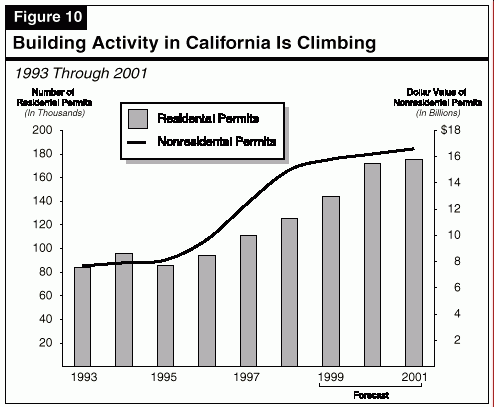
The projected increase in real estate sales and construction activity is a key element behind our forecasts for continued gains in the finance, construction, and various manufacturing sectors in the state.
Last fall, some leading national forecasters rated the risk of a recession in 1999 as high as 50�percent. Since then the risks of a near-term economic
downturn have faded significantly, due to the current
momentum in the U.S. economy and the rebound in the U.S. stock market. In fact, as this report went to press, the performance of the national economy
was continuing to exceed expectations. Nevertheless, both the U.S. and California economies continue to face significant threats in late 1999 or in 2000,
primarily related to a possible worsening of the global financial
and economic situation. A second, and potentially related, risk is that the U.S. stock market will experience a steep and sustained drop in value, leading to
a significant erosion in U.S. consumer wealth, confidence, and spending.
Most economists believe that if a recession were to occur, it would be relatively mild by historical standards, with the Federal Reserve Bank being able to blunt the impact of the downturn through reductions in interest rates.
Figure�11 (see next page) compares our current economic forecasts for the nation and California to our November 1998 forecasts (see California's Fiscal Outlook: The LAO's Economic and Budget Projections, November 1998). It also compares them to those of the University of California, Los Angeles (UCLA) made in December 1998, and the Governor's January 1999 budget forecast.
| Figure 11 | |||
| Recent Economic Forecast Comparisonsa | |||
| Percent Changes | |||
| 1998 | Forecast | ||
| 1999 | 2000 | ||
| United States Real GDP: | |||
| LAO November | 3.5% | 1.9% | 2.4% |
| UCLA December | 3.7 | 2.5 | 2.8 |
| DOF January | 3.6 | 1.9 | 2.2 |
| LAO February | 3.8 | 2.6 | 2.1 |
| California Wage and Salary Jobs: | |||
| LAO November | 2.9% | 2.2% | 2.5% |
| UCLA December | 3.2 | 2.4 | 2.6 |
| DOF January | 3.2 | 2.1 | 2.4 |
| LAO February | 3.2 | 2.4 | 2.6 |
| California Personal Income: | |||
| LAO November | 6.8% | 5.2% | 5.6% |
| UCLA December | 6.6 | 5.3 | 5.6 |
| DOF January | 6.3 | 5.1 | 5.5 |
| LAO February | 6.4 | 5.4 | 5.6 |
| California Taxable Sales: | |||
| LAO November | 6.1% | 5.2% | 5.6% |
| UCLA December | 5.5 | 6.2 | 5.8 |
| DOF January | 5.6 | 5.4 | 5.4 |
| LAO February | 5.8 | 5.5 | 5.4 |
| a Acronyms used apply to Legislative Analyst's Office (LAO); University of California, Los Angeles (UCLA); and Department of Finance (DOF). | |||
Compared to both our November forecast and the administration's January forecast (which was prepared late in 1998), we see significantly stronger U.S. growth and modestly stronger California growth in 1999. The improvement reflects the greater near-term momentum in both the national and state economies, particularly in many of the interest-sensitive sectors. It also reflects the rapid recovery in the stock market at the end of 1998, which has added to household wealth and confidence levels.
California's population is highly dynamic along a variety of dimensions--including its growth properties, age composition, ethnic and racial mix, foreign and domestic migration trends, and intrastate mobility patterns. These factors significantly affect, both directly and indirectly, the state's economy, its revenue collections, and its expenditure levels. Consequently, the state's demographic outlook is an important element in assessing and projecting its budgetary situation.
We project that California's population will grow at an average annual rate of 1.7�percent during the next three years, reaching 35.2�million by the year 2001. In numerical terms, California will gain about 1.8�million new residents--a population slightly larger than the Silicon Valley. We expect California's population growth to outpace the nation's in each of the next three years. This is illustrated in Figure�12, which compares recent and forecasted population growth for California and the rest of the nation. As the figure indicates, the state's population growth rate fell below the rest of the nation's during the first half of the 1990s. However, we project that California's population growth rate will be more than double that of the rest of the nation by the end of the decade.
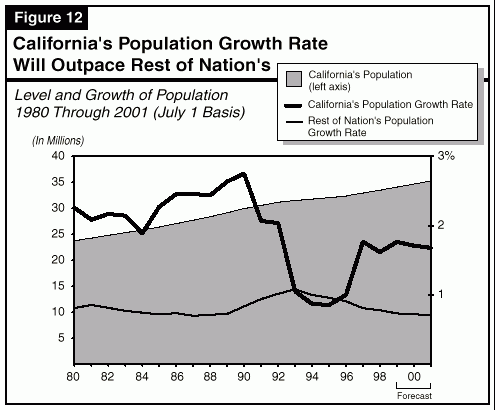
There are two components to population growth--natural increase (the excess of births over deaths) and net in-migration (the difference between the
number of people who migrate to California and the number that leave). Figure�13 (see next page) shows the state's annual population change since 1988,
and documents the contributions of each component. It shows that a sharp decline (and actual outflow in three of the years) in net in-migration is
responsible for the slower state population growth in the early 1990s. Indeed, while natural increase remained relatively stable, net in-migration to
California plunged in concert with California's extremely severe recession. That is, the state's severe recession discouraged people from coming to
California who otherwise would have migrated to the state in search of economic opportunities.
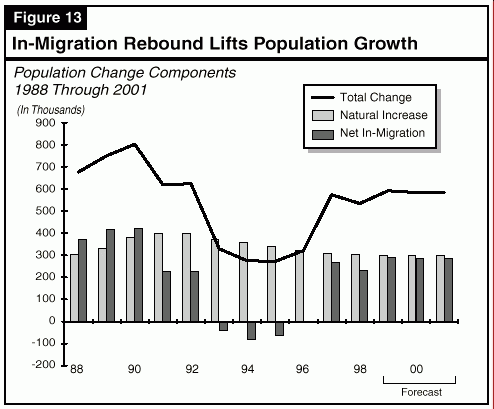
Migration Behavior. In-migration itself can be broken down into two categories: domestic (population movements between California and the other 49 states) and foreign(movements between California and other countries). Substantial numbers of both domestic and foreign migrants made their way to California during the 1980s. California continued to experience a sizable in-flow of residents from other countries during the first half of the 1990s, but this gain was offset by a large-scale net out-migration of Californians to other states. Now that economic conditions have improved in the state, net in-migration has resumed; we expect net in-migration to add an average of 287,000 persons annually between 1998 and 2001.
Rapid changes are also taking place in the age distribution of California's population. Figure�14 shows California's age distribution as of 1998 and how its mix of age groups will change during the next three years. California's workforce will grow older as the baby boomers enter their late 40s and 50s. Indeed, the 25-to-44 age group will stay relatively flat, as the baby boom cohort ages into the next older group. Growth in the K-12 school-age population and the 18-24 age cohort will be somewhat higher than that of the general population. Conversely, the number of preschoolers is projected to decline, while the elderly population is expected to grow moderately.
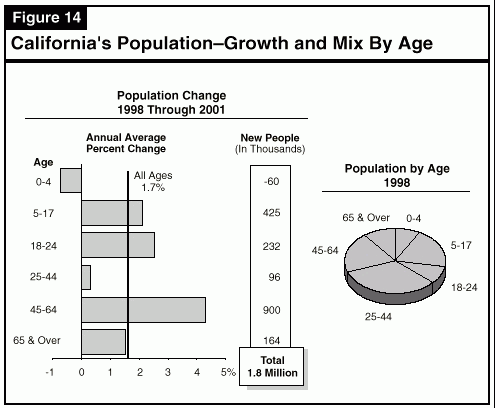
Demographic trends occurring in the state are key determinants of both state revenues and expenditures. In the case of expenditures, for example, program needs are influenced by caseloads, which are a function of such demographic factors as overall population growth and the age characteristics of the population. Likewise, revenues depend on such economic factors as income and job growth, which in turn are influenced by demographic variables such as the size of the labor force and the number of people needing the various goods and services which businesses produce. Similarly, the housing market is affected by the population's age mix and household characteristics.
The rapid changes in the size and composition of California's population will have many implications for the future course of California's economy, and for the volume and mix of public services that will be needed in the budget year and beyond. For instance: